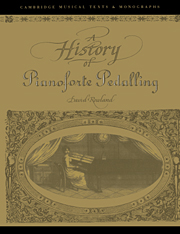Book contents
- Frontmatter
- Contents
- Acknowledgements
- List of abbreviations
- Introduction
- PART I The instruments
- PART II Pedalling and the early pianists
- PART III Pedalling after c.1800
- APPENDIX: Chapters on pedalling from piano tutors
- J. P. Milchmeyer, Die wahre Art das Pianoforte zu spielen. Chapter 5 (Dresden 1797)
- Louis Adam, Méthode de piano du Conservatoire, Chapter 10: The manner of using the pedals (Paris 1804)
- Daniel Steibelt, Méthode de piano (Paris and Leipzig 1809)
- Notes
- Select bibliography
- Index
Louis Adam, Méthode de piano du Conservatoire, Chapter 10: The manner of using the pedals (Paris 1804)
Published online by Cambridge University Press: 16 November 2009
- Frontmatter
- Contents
- Acknowledgements
- List of abbreviations
- Introduction
- PART I The instruments
- PART II Pedalling and the early pianists
- PART III Pedalling after c.1800
- APPENDIX: Chapters on pedalling from piano tutors
- J. P. Milchmeyer, Die wahre Art das Pianoforte zu spielen. Chapter 5 (Dresden 1797)
- Louis Adam, Méthode de piano du Conservatoire, Chapter 10: The manner of using the pedals (Paris 1804)
- Daniel Steibelt, Méthode de piano (Paris and Leipzig 1809)
- Notes
- Select bibliography
- Index
Summary
Nothing on an instrument that adds to the charm of the music, and the emotions, should be neglected, and in this respect the pedals used appropriately and skilfully obtain very great benefits.
The pianoforte can only prolong the sound of a note for the duration of a bar and the sound diminishes so rapidly that the ear has difficulty in grasping and understanding it. Since the pedals remedy this defect and serve at the same time to prolong a sound with equal force for several bars at a time, it would be quite wrong to renounce their use. We know that some people, by a blind attachment to the old rules, by a proper but badly understood affection, forbid their use and call it charlatanism. We will be of their opinion when they make this objection against those performers who only use the pedals to dazzle the ignorant in music, or to disguise the mediocrity of their talent; but those who only use them appropriately to enhance and sustain the sounds of a beautiful melody and fine harmony assuredly merit the approval of true connoisseurs.
Since several composers have written music especially for the use of the pedals, we will first of all acquaint students with their mechanism, and then the manner of their use.
On ordinary small pianos there are only two pedals placed to the left. The one on the outside damps the sounds even more than usual, and one commonly calls it: jeu de Luth [lute] or jeu de Harpe [harp]; it only produces dry and very damped sounds.
- Type
- Chapter
- Information
- A History of Pianoforte Pedalling , pp. 170 - 173Publisher: Cambridge University PressPrint publication year: 1993



